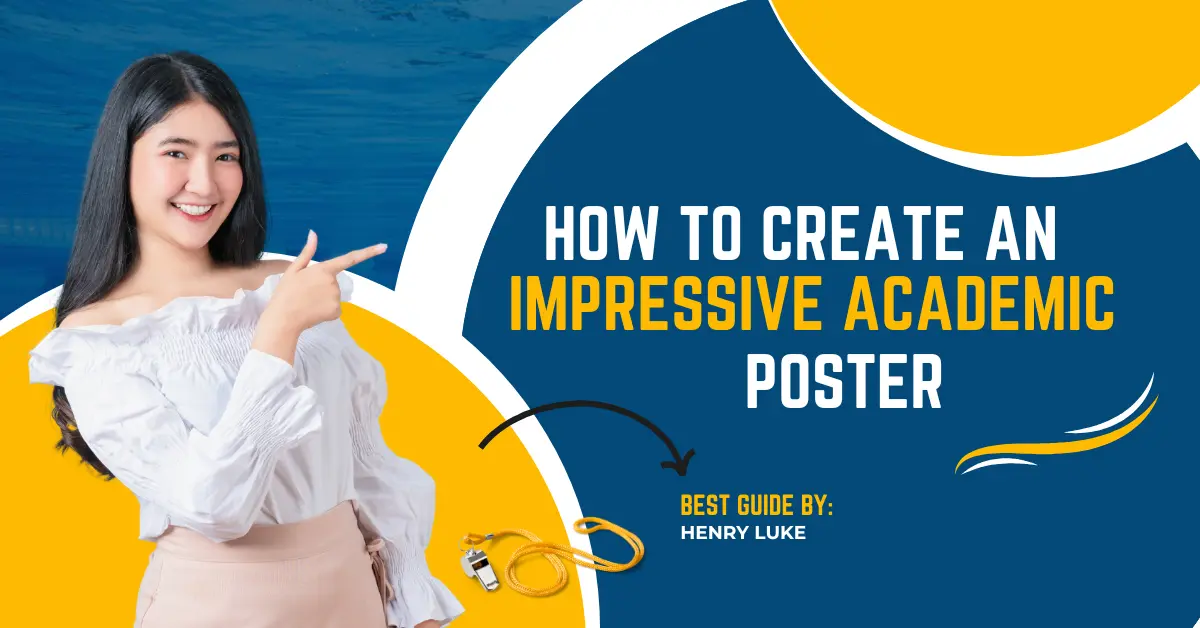Hi, I’m Henry Luke, your academic writing expert at AllAssignmentHelp.org. I’ve helped hundreds of students across Australia build outstanding academic posters that win praise at university events and conferences. Creating an academic poster is more than just printing facts and figures on a big sheet. It’s about telling your research story visually, clearly, and professionally. Whether you’re a university student preparing for a conference or a scholar showcasing findings in a seminar, this blog will walk you through every step to create an impactful academic poster.
-
What Is an Academic Poster?
- Why Academic Posters Matter in Research Dissemination
- Key Elements of a Good Academic Poster
-
Step-by-Step Guide to Creating a Research Poster
- 1. Define Your Purpose
- 2. Know Your Audience
- 3. Choose the Right Academic Poster Size and Format
- 4. Draft Your Poster Content Structure
- 5. Use Academic Poster Examples and Templates
- 6. Design the Poster Layout
- 7. Add Academic Graphics and Data Visualisation
- 8. Focus on Visual Clarity and Readability
- 9. Revise and Proofread
- 10. Practice Your Research Presentation
- Poster Presentation Tips for Students
- Common Mistakes in Poster Design to Avoid
- Designing Posters for Conferences: Dos and Don’ts
- Tools for Academic Poster Design
- Real-Life Example: Emma’s First Academic Poster Experience
- Academic Writing and Presentation: The Bigger Picture
- How AllAssignmentHelp.org Can Assist You
- Final Thoughts: Craft Your Poster with Confidence
- Frequently Asked Questions
What Is an Academic Poster?
An academic poster is a visual communication tool used to present research in a concise, engaging, and informative way. It’s common in university poster presentations, conferences, and symposiums. Unlike a research paper, it focuses more on layout, clarity, and visuals than just written content.
Why Academic Posters Matter in Research Dissemination
Academic posters are a vital method for disseminating research findings. They allow you to:
- Share your work with a broader audience
- Get feedback from peers and professionals
- Increase the impact of your findings
- Network with others in your field
A well-crafted poster can spark interest and create opportunities.
Key Elements of a Good Academic Poster
Your poster should not only inform but also attract attention. The core elements include:
- Title: Clear and brief
- Author Information: Your name and affiliation
- Introduction: The background or aim
- Methods: What you did
- Results: Key findings with visuals
- Conclusion: Summary and implications
- References: (if applicable)
- Contact Details: Optional but useful
Step-by-Step Guide to Creating a Research Poster
1. Define Your Purpose
Start by asking: What is the main takeaway you want viewers to leave with? This focus will shape the rest of your design.
2. Know Your Audience
Design changes based on the intended audience. A scientific conference will need a different depth and tone compared to a student seminar.
3. Choose the Right Academic Poster Size and Format
Common poster sizes:
- A0: 841mm x 1189mm
- A1: 594mm x 841mm
- A2: 420mm x 594mm
Check submission guidelines before finalising.
4. Draft Your Poster Content Structure
Keep sections short. Use bullet points, not paragraphs. Stick to the 20-20 rule: 20% text, 40% visuals, 40% white space.
5. Use Academic Poster Examples and Templates
Start with a proven structure. PowerPoint, Canva, and Adobe Express offer useful templates for beginners.
6. Design the Poster Layout
Make it easy to follow from top left to bottom right. Use columns or grids.
7. Add Academic Graphics and Data Visualisation
Use:
- Charts (bar, pie, line)
- Diagrams
- Photos
- Icons
Label everything clearly.
8. Focus on Visual Clarity and Readability
Follow these tips:
- Use sans-serif fonts (Arial, Calibri)
- Font sizes: Title (72pt), Headings (48pt), Body (24pt)
- Stick to 2-3 colours
- Maintain good contrast (dark text on light background)
9. Revise and Proofread
Check grammar, spelling, and factual accuracy. Ask someone else to review.
10. Practice Your Research Presentation
Be prepared to discuss your poster. Prepare a 1-minute summary, a 3-minute talk, and answers to common questions.

Poster Presentation Tips for Students
- Stay by your poster during the session
- Make eye contact and smile
- Be confident but concise
- Use hand gestures to highlight key parts
- Thank you viewers for stopping by
Common Mistakes in Poster Design to Avoid
- Overloading with text
- Poor image quality
- Small font sizes
- Cluttered layout
- Unclear research aims
- No clear flow
Designing Posters for Conferences: Dos and Don’ts
Dos:
- Do include your university logo
- Do focus on one main message
- Do leave white space for breathing room
Don’ts:
- Don’t use fancy fonts
- Don’t clutter your poster
- Don’t rely on visuals without explanation
Tools for Academic Poster Design
- PowerPoint: Widely used, easy to access
- Canva: Great for visual layouts
- Adobe Illustrator: Professional option for advanced users
- Lucidchart: For flowcharts and diagrams
Real-Life Example: Emma’s First Academic Poster Experience
Emma, a psychology student at a university in Australia, created her first academic poster using PowerPoint. She focused on visual communication by using a clear title, simple graphs, and a limited colour palette. She received praise from lecturers and was invited to present at a national seminar.
Academic Writing and Presentation: The Bigger Picture
Your poster is an extension of your academic writing. Maintain clarity, professionalism, and factual accuracy. Use citations where necessary and maintain a consistent tone.
How AllAssignmentHelp.org Can Assist You
Struggling with formatting, structure, or design? Our academic experts can help you craft a powerful poster. Whether you need writing, editing, or design support, we’re here to ensure your poster reflects your hard work.
Final Thoughts: Craft Your Poster with Confidence
An impressive academic poster blends clarity, creativity, and confidence. Please keep it clean, concise, and engaging. Use strong visuals, avoid clutter, and ensure clarity in your message at all times. With practice and guidance, you’ll master the art of academic poster design.
Read more: Why Acknowledge Education Is a Top Choice for International Learners
Frequently Asked Questions
What is an academic poster and why is it important?
An academic poster shows your research in a clear, simple way using text and visuals. It helps others understand your work quickly at events like conferences and uni fairs.
How can I make my academic poster easy to read?
Use big fonts, short bullet points, and clean designs. Stick to light backgrounds, simple words, and strong headings. Avoid clutter and fancy styles.
What size and format should I use for my research poster?
Most uni events accept A0 or A1 sizes. Check their rules first. Always design your poster in landscape unless told otherwise.
Can AllAssignmentHelp.org help me design my academic poster?
Yes! Our experts can help with poster content, layout, visuals, and editing. We make sure your poster looks great and shares your ideas clearly.








